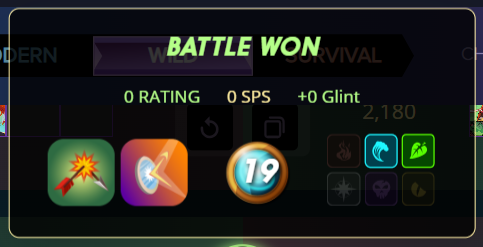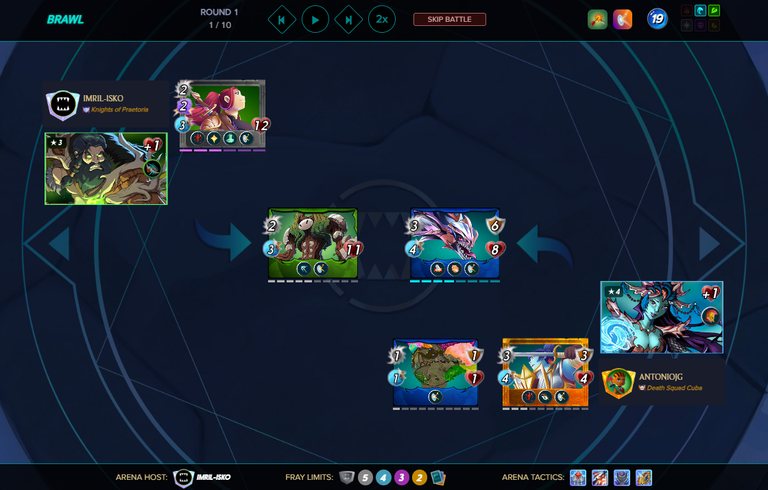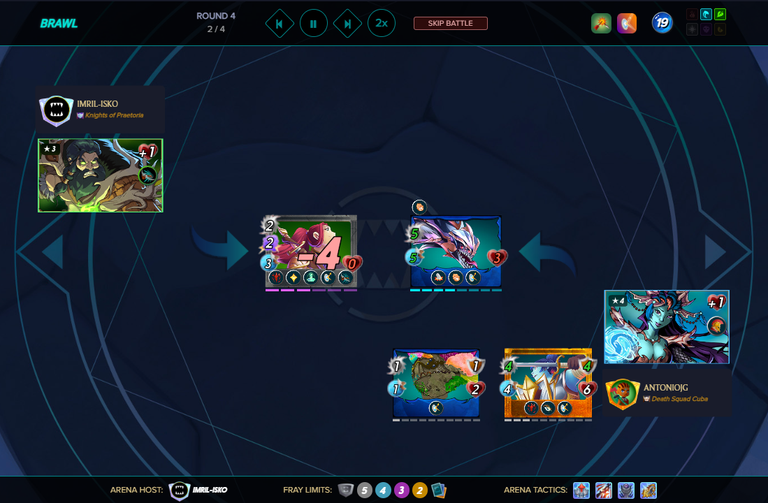Una estrategia efectiva con Isgald Vorst en una batalla con poco maná [Es/En]

Español
¡Saludos comunidad! En el reto de esta semana quiero compartir con ustedes un análisis de mi experiencia utilizando una estrategia con el Splinter de Agua. La cual considero una excelente opción para aquellas partidas con un límite de maná bajo y con las reglas “Broken Arrows” y “Counterspell”. Es importante recordar que el tipo de ofensiva a utilizar en nuestras estrategias también dependerá del resto de reglas presentes en la batalla.
En esta oportunidad, les explicaré cómo afronté una batalla de Brawl de la liga de Plata en el formato Salvaje, enfocando mi análisis en explicar cómo utilicé al Splinter de Agua, el invocador Pembrook Nymph y a las unidades Diemonshark, Isgald Vorst y Hardy Stonefish para ser coherente con las reglas de batalla presentes y las habilidades que quería combinar con la finalidad de tomar ventaja en la partida con la estrategia planteada.
Ya que estos aspectos son un factor clave con un impacto considerable en el desempeño de nuestras estrategias.

Conjunto de reglas y elección

Hablemos sobre el conjunto de reglas presentes en la batalla, este es el punto de partida para iniciar el análisis que nos llevará a la elección más adecuada para afrontar la batalla.
Límite de maná igual a 19 puntos, esta cantidad nos permite elegir invocadores con un costo de maná entre 4 y 7 puntos. Sin embargo, es importante tener una estrategia bien definida para elegir a las unidades adecuadas con el maná restante.
Broken Arrows es una regla que no permite utilizar unidades tipo Ranged en la batalla. Por otra parte, Counterspell, otorga a todas las unidades la habilidad “Magic Reflect”.
Entonces, tomando en cuenta todos estos aspectos, decidí utilizar al Splinter de Agua, ya que cuenta con unidades que poseen buenas estadísticas, entre ellas, un buen ataque melee. También cuenta con habilidades como: “Trample”, “Enrage”, “Bloodlust”, “Opportunity”, entre otras, y con un invocador que incrementa en 1 punto la vida del equipo, y permite utilizar una unidad de tipo Gladius en la batalla.

Equipo y estrategia

Hablemos sobre el equipo y la estrategia que conforma. Dadas las circunstancias, era evidente el uso del tipo de ataque melee. Es por ello que decidí utilizar el invocador Pembrook Nymph, ya que incrementa en 1 punto la vida del equipo, y permite utilizar una unidad de tipo Gladius en la batalla.
Diemonshark actuó como tanque en esta oportunidad, ya que posee buenas estadísticas, entre ellas, sus puntos de vida, armadura y ataque melee. También cuenta con las habilidades “Trample” y “Enrage”, las cuales le permiten aprovechar mejor sus ataques.
Isgald Vorst es la unidad clave de la estrategia, ya que se encarga de atacar a las unidades más débiles del equipo enemigo, a través de la habilidad “Opportunity”. Además, como cuenta con “Bloodlust”, tiene el potencial de incrementar considerablemente sus estadísticas.
Hardy Stonefish sólo actúa como una carnada para proteger al resto del equipo de posibles ataques enemigos de tipo “Sneak” u “Opportunity”.

Estrategia en acción

Como les mencioné anteriormente, elegir al invocador Pembrook Nymph y a las unidades Diemonshark, Isgald Vorst y Hardy Stonefish, fue una buena opción. Sin embargo, también es importante incluir habilidades de soporte que le permitan a nuestro tanque y al resto del equipo, resistir lo suficiente.
Observen como para el turno 2 de la ronda 4, el equipo enemigo estaba casi abatido. Diemonshark resistió lo suficiente en la primera posición para que con ayuda de Isgald Vorst pudieran derrotar a Quora Towershead nivel 3.
Si quieres ver la batalla completa, acá te dejo el enlace: CLIC PARA VER LA BATALLA

Conclusión
La estrategia planteada hizo un uso eficiente de la cantidad de maná disponible, cubriendo aspectos tales como: resistencia contra el daño enemigo, soporte del equipo, una buena ofensiva, y coherencia con el conjunto de reglas presente.
Una debilidad de esta estrategia es un equipo enemigo que cuente con resistencia a los ataques melee e incluya habilidades como: “Shield”, “Protect”, “Repair”, “Demoralize”, “Retaliate”, “Thorns”, “Heal”, “Tank Heal”, “Triage”, “Amplify”, entre otras.
La diferencia entre las estrategias fue que el daño de mi ofensiva era más elevado que la capacidad de curación del equipo enemigo.
Para el funcionamiento adecuado de nuestras estrategias, es importante considerar todos los aspectos involucrados, por lo que no sólo debemos enfocarnos en las estadísticas y habilidades a combinar. También debemos tener en cuenta la influencia de los conjuntos de reglas sobre la estrategia.
Este ha sido mi aporte al desafío semanal, ¡Espero haya sido de su agrado! ¡Saludos y hasta la próxima semana!

English
Greetings community! In this week's challenge I want to share with you an analysis of my experience using a strategy combining Water and Dragon Splinters. Which I consider an excellent option for those games with a high mana limit and with the rules “Unprotected” and “Explosive Weaponry”. It is important to remember that the type of offensive to use in our strategies will also depend on the rest of the rules present in the battle.
In this opportunity, I will explain how I faced a Silver League Brawl battle in the Wild format, focusing my analysis in explaining how I combined the Water and Dragon Splinters, the summoner Helios Matriarch and the units Djinn Oshannus, Tide Biter, Kulu Mastermind, Isgald Vorst, Deeplurker and Edith Emberstar to be coherent with the battle rules present and the abilities I wanted to combine in order to take advantage in the game with the strategy proposed.
Since these aspects are a key factor with a considerable impact on the performance of our strategies.

Rulesets and choise

Let's talk about the set of rules present in the battle, this is the starting point to begin the analysis that will lead us to the most appropriate choice to face the battle.
Mana limit equal to 19 points, this amount allows us to choose summoners with a mana cost between 4 and 7 points. However, it is important to have a well-defined strategy to choose the right units with the remaining mana.
Broken Arrows is a rule that does not allow the use of Ranged units in battle. On the other hand, Counterspell, grants all units the ability “Magic Reflect”.
So, taking into account all these aspects, I decided to use the Water Splinter, since it has units with good stats, among them, a good melee attack. It also has abilities such as: “Trample”, “Enrage”, “Bloodlust”, “Opportunity”, among others, and a summoner that increases the team's life by 1 point, and allows the use of a Gladius type unit in battle.

Team and strategy

Let's talk about the team and its strategy. Given the circumstances, it was obvious to use the melee attack type. That is why I decided to use the summoner Pembrook Nymph, as it increases the team's health by 1 point, and allows the use of a Gladius type unit in the battle.
Diemonshark acted as a tank in this opportunity, since it has good stats, among them, its health points, armor and melee attack. It also has the “Trample” and “Enrage” abilities, which allow it to make better use of its attacks.
Isgald Vorst is the key unit of the strategy, since he is in charge of attacking the weakest units of the enemy team, through the “Opportunity” skill. In addition, as he has “Bloodlust”, he has the potential to increase his stats considerably.
Hardy Stonefish only acts as a bait to protect the rest of the team from possible enemy attacks of the “Sneak” or “Opportunity” type.

Strategy in action

As I mentioned before, choosing the summoner Pembrook Nymph and the units Diemonshark, Isgald Vorst and Hardy Stonefish was a good choice. However, it is also important to include support abilities that allow our tank and the rest of the team to resist enough.
Notice how by turn 2 of round 4, the enemy team was almost down. Diemonshark resisted enough in the first position so that with the help of Isgald Vorst they could defeat Quora Towershead level 3.
If you want to see the complete battle, here you have the link: CLICK TO WATCH THE BATTLE

Conclusion
The strategy proposed made an efficient use of the amount of mana available, covering aspects such as: resistance against enemy damage, team support, a good offensive, and coherence with the present set of rules.
A weakness of this strategy is an enemy team that has resistance to melee attacks and includes abilities such as: “Shield”, “Protect”, “Repair”, “Demoralize”, “Retaliate”, “Thorns”, “Heal”, “Tank Heal”, “Triage”, “Amplify”, among others.
The difference between the strategies was that the damage of my offense was higher than the healing capacity of the enemy team.
For the proper functioning of our strategies, it is important to consider all the aspects involved, so we should not only focus on the stats and skills to combine. We must also take into account the influence of the rule sets on the strategy.
This has been my contribution to the weekly challenge, I hope you enjoyed it! Greetings and see you next week!

Te invito a seguirme en / I invite you to follow me on: Twitter
Las traducciones fueron realizadas con el traductor / Translations were done with the translator: DeepL
Todas las imágenes fueron tomadas de / and all images were taken from: Splinterlands

https://x.com/AntonioJGB92/status/1913729695297704201
https://www.reddit.com/r/Splinterlands/comments/1k38qud/una_estrategia_efectiva_con_isgald_vorst_en_una/
The rewards earned on this comment will go directly to the people( @antoniojg ) sharing the post on Reddit as long as they are registered with @poshtoken. Sign up at https://hiveposh.com. Otherwise, rewards go to the author of the blog post.
Thanks for sharing! - @lenonmc21

¡Gracias! | Thanks! ✌️